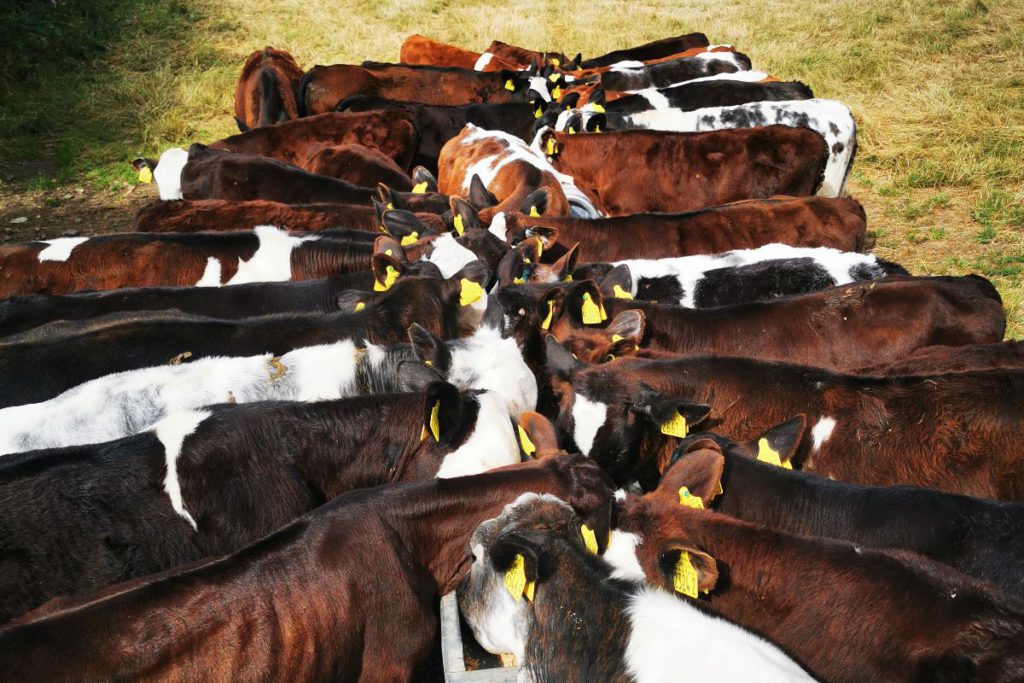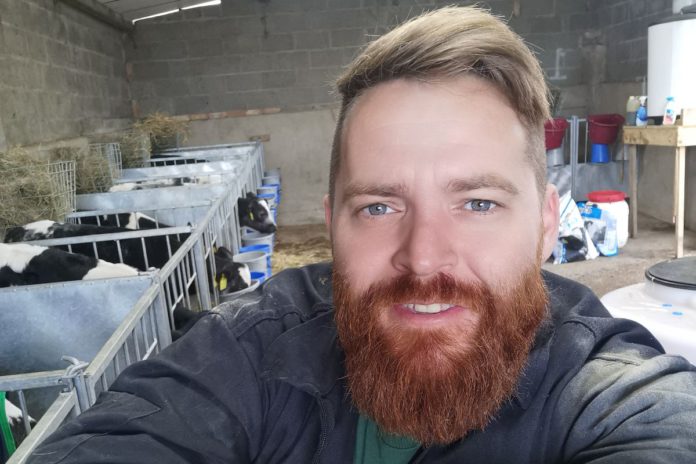That’s Farming editor, Catherina Cunnane, in conversation with Glen Crooks, Co Tyrone, in this week’s Farmer Focus segment. Best known as ‘The Calf Man’ on Instagram, he discusses running a dairy calf-to-beef operation with his father-in-law, successful calf rearing techniques and yard and land improvements.
“I left a 14-year career working in and out of the Middle East and West Africa and came home; that is when I fell in love with farming.
It was a natural fit and being someone who strives to learning every day, it was a natural choice to pursue further education in the agri-food sector.
5 years ago, I didn’t know the difference between a bullock and a heifer. Today, I have the sole responsibility of rearing every animal that comes through the farm.
I run a farm with my father-in-law, Robert. The farm has been in the family for over 100 years. I am a mature student at CAFRE Greenmount on a part-time basis and spend the rest of my time on the farm.
Calf-to-beef farmer
We have 70 reared heifer calves, a mixture of Belgian Blue-crosses and Hereford-crosses. We will breed them to a Speckle Park in the summer of 2022 in the hope to have some nicely marked, low-maintenance females.
There may also be the opportunity to have some of these cross-bred heifers take on a second calf to help lower the cost of milk replacer.
Even when we are ‘dabbling’ in suckler cows in the future, it won’t be in a conventional manner.

Breeds, sexes and ages
In total, we rear 150+ dairy-bred calves per annum. We have developed a strong relationship with three dairy farmers. We take almost all of their calves and by mid-2022, we hope to take all of them.
As soon as the BVD sample is back clear, between 1 and 4 weeks approximately, calves arrive on-farm.
We keep a constant flow of batches of young bulls and slaughter them before 15 months. We castrate the majority, killing these between 22-26 months. Breeds are as follows: 40% BB, 40% Hereford, 10% Aberdeen-Angus and 10% other.
We try to take on 70% bull calves and 30% heifer calves, but at times, we just take whatever healthy calf is available at the time.
Once we have taken the next step in mid-2022, we intend to take all calves available. We have already reared and sold breeding heifers at 15 months. Our buyers were extremely happy, so there is an opportunity to exploit that market in the future.
We have found that cash flow is far more positive than a suckler-beef operation, with batches going to slaughter or sold privately on a more frequent basis.
Although we no longer get those U grade, heavy bullocks going to slaughter, we are also not writing big cheques for one beast, and the reared calf leaves a lot more behind.
Number crunching
I am a number cruncher, with weights recorded and keeping a strict eye on DWLG. I am fit to move along those not converting on grass and concentrate and keep those performing well.
Calf rearing, involving dairy-bred calves, is a viable enterprise. However, it is not to be entered into light-heartedly.
They require a sharp eye, strict vaccination programmes, attention to detail and hygiene and involve more labour on the farm.
If a farmer isn’t willing to give that level of commitment and thinks it is as simple as buying a calf, feeding a calf and slaughtering, then there will be a rude awakening. We learned the hard way and now boast a sub 1% mortality rate, 2 years in a row.

Goals
We are in the middle of putting up a new calf shed and cattle house. This will increase our housing capacity by 35%. We are intensifying every year and growing the herd size.
2 years ago, we housed 120 cattle and grazed 150 at the most. This year, we grazed 250 and are housing 220. Next year, we look likely to graze 250, finish 70 housed bulls and winter 300.
We are blessed to have a large stretch of land all around the yard and little to no rented ground.
This year will see us finish our focus in the yard to shift that focus to the land next year. We need to optimise on the ground available to us.
Reseeding and setting up fencing and water sources to allow rotational grazing is the next step in 2022. I like to set weekly, monthly, yearly and three-year goals.
In the more distant future, I would like to see an additional enterprise on the farm, something which will allow more a regular income to complement the calf-to-beef operation.

Greater integration of beef and dairy farming.
Although a controversial subject, I would have to say there is a need for greater integration of beef and dairy farming.
The calves are there and many dairy farmers haven’t the facilities, time or grass to bring them to finish themselves.
Somebody has to take them and having been in the position of buying big cattle and taking them to finish, it was a no brainer to us.
In my view, there just isn’t enough room for a margin when buying a big continental-type at £900-£1,000, keeping him until 26-30 months, throwing meal at him and killing him for 380-400ppk and that’s in a good year.
None of the above is a poke at the suckler farmer. They absolutely need the big money for their weanling and deserve it.

Meal and beef prices
The blame lies solely at the cost of meal and the rise and fall of the beef market. Margins are tight and farming is a business.
Considering I am not a suckler farmer my opinion is solely speculative, but I think the smaller sized suckler herds will dwindle away a bit, leaving bigger outfits supplying bigger beef finishing lots.
There will always be a place for suckler farmers, but I do think there is a risk of margins dictating a smaller demand for their product. I hope I am wrong though.
Farmers are not rewarded enough for the quality progeny they are producing. They would be if beef prices rose and meal/fertiliser etc prices fall,” the calf-to-beef farmer concluded.
Follow The Calf Man on Instagram.
To share your story like this calf-to-beef farmer, email – [email protected]





